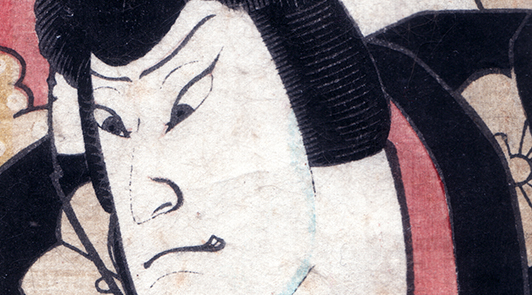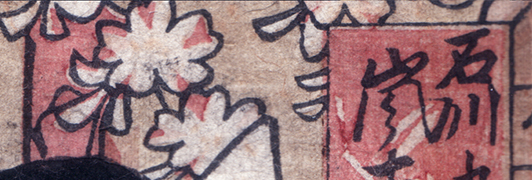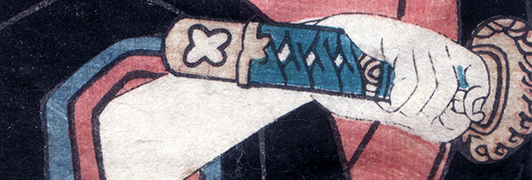When I think of teaching graphic design at Ravensbourne, my thoughts often turn to Geoff White. I remember the moment he gave me an exquisite, original woodblock print of a samurai.
Geoff offers it with a sense of reverence, remarking on the way the artist has captured the essence of the warrior spirit through bold and nuanced brushstrokes and planes of color. The Samurai focuses intently, gazing beyond the border, hand grasping his sword, the katana, caught in the moment of deliberation. The curve of the handle, the tsuka, is counterpoint to the sweep of his kimono as he leans in. It’s an intimate moment where time stops and details come into focus. The single line of the swordsman’s downward-curved mouth; the shape of his fierce fingers pressed against the braid of sage-colored silk on the ito, the handle wrap; the pattern of calligraphy and flowered-banners in the background. It’s a moment of honor and discipline. Life hangs in the balance.
I hold my breath. Geoff smiles, watching me carefully. I sense I have just received a gift and a teaching that will unfold its deeper meaning over time.
Pattern recognition
Now I understand, nearly forty years later, about mastery. I see the fractal pattern: the Samurai (Master of the Way of the Sword, Zen, and Brush) — given by Geoff White (Master of Design, Typography, and Education) — to me (now, a Master of Sea Change Design.) Each one of us is a sensei, a teacher in our own right, adhering to our own codes of aesthetics and virtues, set within different historical contexts, countries, and cultures.
Yet there are similar strands of mastery that I can braid together in this storyline. The Samurai of feudal Japan depicted in my gift would have followed the Bushidō (Way of the Warrior) code of seven virtues, which include benevolence or a desire to help others (jin), respect (rei), and taking right action or acting with integrity (gi). What better ethics would describe Geoff’s work and way in the world? Or mine, for that matter.
Jin: Benevolence
Newly emerged from the chrysalis of my design education in 1979, I benefited from Geoff’s benevolent, humble, and insightful role-modeling as a tutor. We shared a commitment to guide young designers, delighting in their explorations and growing knowledge of the fundamentals. Geoff called it studying “the vocabulary of form” in order to strive for solutions that were “precisely right.” I agreed, encouraging the students to practice the basics, much like how the Samurai learned the art of calligraphy. My intention was similar, to strengthen their characters and enliven their spirits as they learned how to unite beauty with meaning.
Rei: Respect
Geoff and I spoke the same design language, rooted in our deep respect for the design legends, Armin Hofmann and Wolfgang Weingart, two of my professors at the Schule für Gestaltung Basel where I completed my postgraduate studies. I brought a Swiss design sensibility, rigor, and love of experimentation to my class assignments, emphasizing the search for the quintessential essence of a clear communication. I also taught what I first experienced in my undergraduate studies at Rhode Island School of Design, insisting my students begin with paintbrush and plaka. Even then, I knew that mastery emerges between the hand, the eye, the mind, and the heart. It’s similar in spirit to this Bushidō motto: “The warrior needs to master the bow and the horse as well as the brush and the word.”
Gi: Right Action
That autumn in my letterform class at Ravensbourne, I fell in love with teaching. I looked forward to the one day a week I traveled by train to the college in Chislehurst, Kent from London where I was working with FHK Henrion on international corporate identity programs. (Henrion was also head of Visual Communication at The London College of Printing at that time.) I was immersed in the exciting world of British design. It was a formative time for the design profession around the globe, which was evolved enough for us to see its growing power in influencing business, society, and the environment.
For designers like Geoff and me, it was imperative to teach within the greater context of design’s impact and relevance. We did this by encouraging our students to design with integrity, not only from a sense of personal responsibility, but with an awareness of the difference taking right action can make on a viable future. I’m still teaching this today. At the Sea Change Design Institute we empower individuals and organizations to develop “design consciousness,” a thriving state of being that engenders co-creative and vital connections between humanity, nature, spirit, and time.
There are many masterful Design Warriors at work today, some poised in mid-action as the Samurai is — deliberating what will serve Life best. I study the Samurai’s face, his grace, his conviction. And I imagine inviting him to have tea. We talk intently about walking in the Way of Design.
______
My reflection will appear in the book and exhibit, The School of Graphic Design at Ravensbourne 1963–Present, currently being co-edited by Andrew Slatter and Paul Blackburn. It will celebrate and document the unique place Ravensbourne has within the landscape of graphic design education in the UK. While I am not a scholar of Bushidō, my intent in referring to it is to be faithful to the spirit of the unwritten, timeless, and relevant code of the Way of the Warrior. I offer great gratitude to my friend and fellow Design Warrior, Geoff White, who died this year at 90.







hello[at]seachangedesign.com
+1.831.426.8026
Sea Change Design Institute
317 Arroyo Seco
Santa Cruz CA
95060 USA